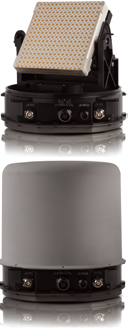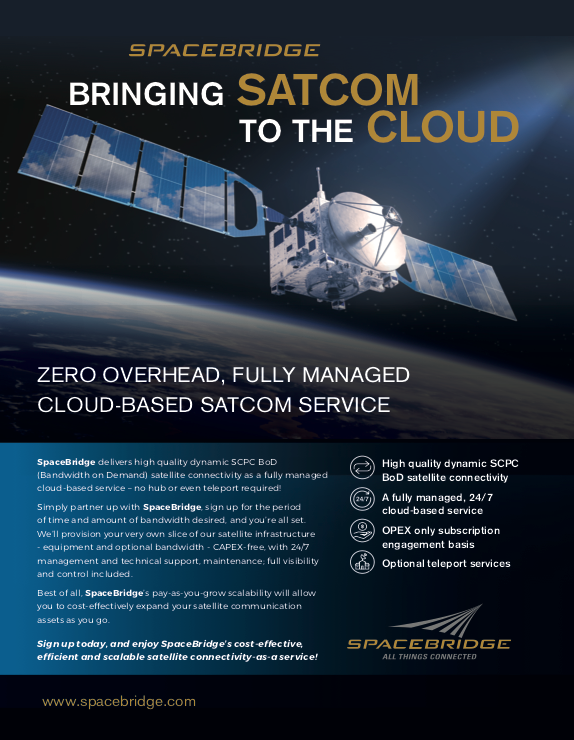Global communications are driven by high-bandwidth applications needing high data rate connections. On the battlefield it is no different; however, the delta between civilian life and the limitations and challenges of the military loom large.

Today, high bandwidth connections are becoming essential for providing optimal conditions to boost critical mission success on the battlefield. High bandwidth data is mandatory. Decisions based on miscommunication or limited access to data made by commanders, officers and soldiers can literally change a person’s life, whether combatant or civilian.
To tilt the fulcrum toward better decision making, militaries, defense services, HLS and security agencies are seeking the best high bandwidth communication tools that enable instantaneous access to more information and even more so, to real-time communications.
Delivering real-time intelligence data, maps, live videos, mission information, enemy profiles and movement in an on-the-move situation requires communications capabilities of the highest order. Decisions impacting life and death need to be predicated on as close to full knowledge as possible.
High speed SOTM improvement not only impacts the military. Various HLS and security missions, such as search and rescue operations, disaster recovery and relief, coastal security and other Communications-On-The-Move (COTM) operations, will also greatly benefit.
What are High Bandwidth Communications?
High bandwidth is today’s reality — try a day without using your smartphone and its applications and see how frustrating such an experience will be for you.
Having data flow with low latency — as close to instantaneous communication as possible — is another real need. In the civilian
world, this is currently at the LTE as well as 5G stages that provide data speeds between 5 and 12 Mbps and upload speeds between 2 and 5 Mbps. The same is needed for the military’s on-the-move requirements.
As soldiers in the field, vehicles, vessels or airborne platforms are constantly in dynamic mode, they need these capabilities in a secure and rugged instrument in an on-the-move format.
Satellites are the answer for soldiers in the field requiring MILCOM COTM. Satellite beams are fast, reliable and reachable and offer a major advantage with unparalleled Beyond-Line-Of-Sight (BLOS) reach. The only answer while in the field to receive from, and transmit to, a satellite are technologically advanced, small, lightweight satellite communication SOTM (SATCOM-On-The-Move) terminals.
These terminals ability to attain seamless on-the-move communications furthers flexible tactical and strategic decision-making processes on constantly changing battlefields, war zones, disaster areas, behind enemy lines and elsewhere. These terminals enable decision makers in the field, in front-line command posts as well as BLOS rear HQ to see, hear and communicate in real time. This means that a full comms link package located within the confines of a ‘man-pack’ is usable for a far longer period of time over the horizon — plus, such capabilities are here and now.
This new era of real-time video, audio and data flow comes via the development of an ultra-portable lightweight, only 3.6 kg., low-profile terminal optimized for ‘on-the-move’ applications: the Nano SAT-H. This is the first manpack in the world, based on SATCOM, that realizes the desire for high data rates.
Forty years ago, battlefield comms for an individual soldier or small unit was voice only. Today, comms capabilities are quite different.
The Nano SAT-H provides live feeds, live human data interfaces (such as email and chat), instant data applications for downloading or uploading maps, enemy profiles and changing mission tasks. Both in the field and at command posts, intel information can be relayed for 3D modeling of buildings, tunnels and other infrastructure, varied maps such as heat, Elint, Search and Rescue, population density. Additional data types can be loaded or changed to reflect new and refreshed knowledge and provide updated information in the field and for HQ.
With secure, high bandwidth communications ‘man-pack,’ the field of action changes. The Nano SAT-H quickens the process of providing and delivering information.
No longer does a soldier need to rendezvous with a mobile communication vehicle. No longer do warfighters have to visit a frontline HQ tent to obtain new maps or upload mission results or to view the next mission. Now this all comes in through the soldier’s Nano SAT-H ‘man-pack’ unit. Imagine the time and effort saving this provides for the warfighter and the unit. Now they can focus on the mission — this is a win-win for all.

Get SAT’s Nano SAT-H
antenna. Top, without
radome. Below, with
radome. Images are
courtesy of the company.
Think of the soldier having a ruggedized ‘smartphone’ connected to the Nano SAT-H. Now, that is progress. This competitive advantage changes the field, improving mission success rates.
Nano SAT-H terminal provides autonomous operation for transmission and reception of high bandwidth data rates at 4 Mbps between ground forces and headquarters. To meet milspecs, the terminal is fully ruggedized to withstand the harshest blows and atmospheric changes. With integrated BUC, LNB and ACU within the terminal, the SAT-H terminal offers a single point of contact without having to add equipment.
Based on highly miniaturized technologies, that together create a small profile unit that fits into a small backpack, the terminal literally replaces equipment that previously would have a filled a mobile communications truck.
The next exciting story behind the creation of the Nano SAT-H is its applications for UAVs. Suffice it to say: Size and Weight do matter.
The terminal’s 3.6 kg. weight for a full broadband comms package, including an integrated BUC, allows the UAV a longer ride in the air and the unit’s size enables builders and integrators to add more systems and technologies within the UAV. Additional time in the air, plus greater technological efficiencies, augment mission goals and enable greater horizons for UAV deployments.
Looking at the evolution of UAV technologies, especially including Class variations, the dilemma of length versus size versus capabilities has always been how to fit more technologies into a smaller size, or how to fit more technologies into a standard size. Creating UAVs that stay aloft for longer periods of time creates a delicate tug between fuel, mobility and capabilities. Giving up in one area leads to gains in another facet. This means matching the payload to the mission has been a critical consideration. However, this does not need to be the case.
Nano SAT-H’s mini size provides a small SATCOM package that literally makes it a micro-comm but with the power of something far larger in size. With this power in a small package, the need to allocate resources to either enhance mission goals or payload capabilities can be eliminated. As the terminal’s size is only 21 x 23 cm. (8.2 x 9 inches), it is the smallest miniature terminal that is capable of handling high bandwidth requirements.
Today a small Class III tactical UAV, those in which the Nano SAT-H are deployed, deliver 4K UHD video feeds from five different cameras. Only two decades ago, video feed was black and white with low definition. Times have changed and UAV capabilities have grown exponentially.
www.getsat.com
Get SAT, the developer of the Nano SAT-H, is a pioneer in small, lightweight satellite communication terminals. Focusing on micronizing SATCOM antenna technologies, the company targets SOTM applications: in the air; on the ground; and on the seas.
Get SAT’s technologies are based on the firm’s patented, fully-interlaced, Inter-FLAT panel technology: a single antenna panel that provides full transmission and reception. InterFLAT’s dual capabilities significantly decrease antenna and thus terminal size, bulk and weight as compared to traditional antennas utilizing different panels for Tx and Rx.
With less weight and size, the Nano SAT-H is optimized for mobility and man carried portability. Pulled together, its technologies increase power efficiency, reduce electrical interference and enhance capabilities. Each small step creates a better product that outdistances earlier technologies.
SATCOM terminal miniaturization is heading in the correct direction. GetSAT is fulfilling the vision with small, mobile, rugged and robust SOTM terminals. The company is empowering HLS, security and defense agencies to push their operations further, faster and smarter. Hand-held SATCOM communicators will be realized far sooner than many might believe to be the case.


